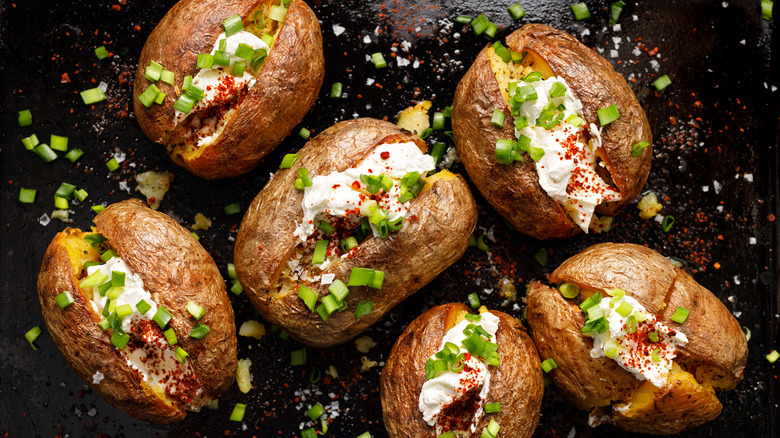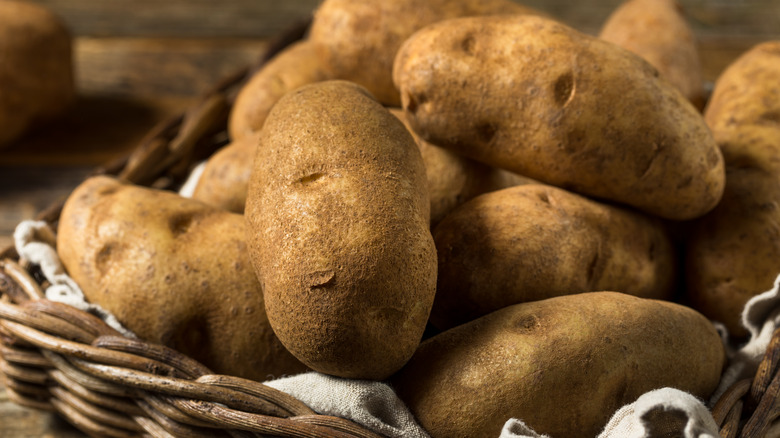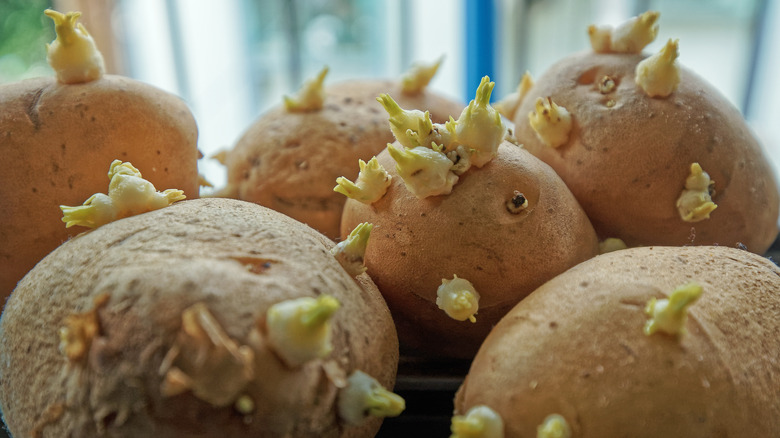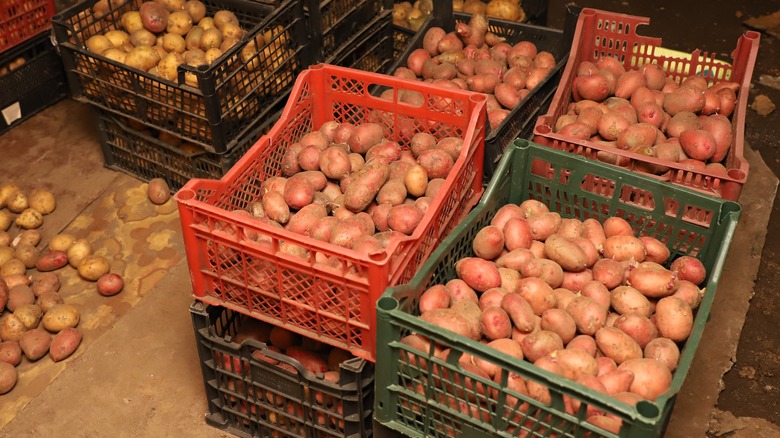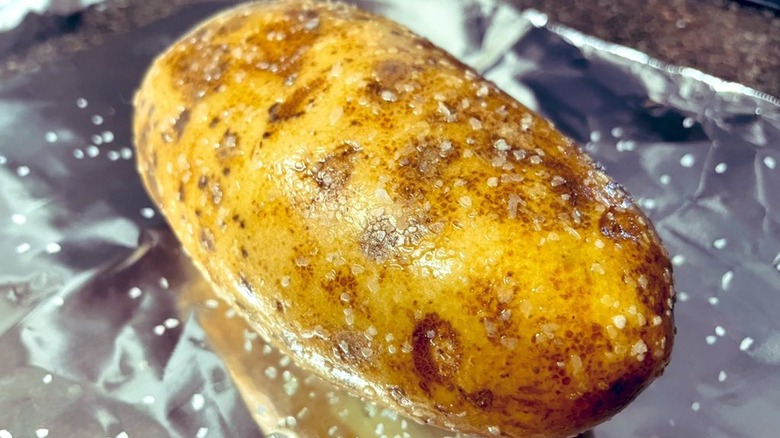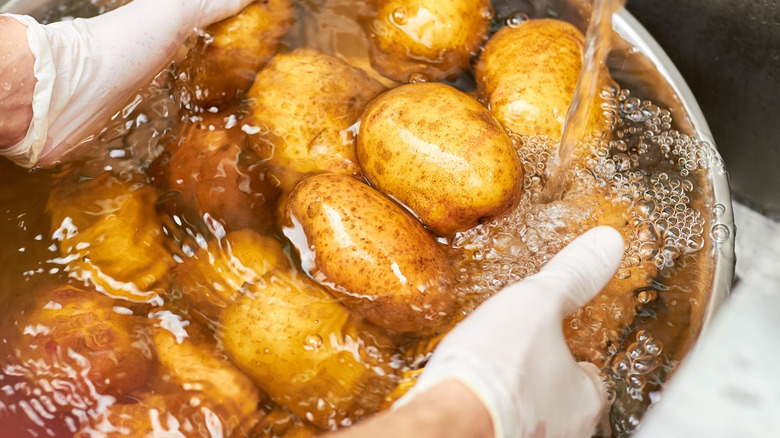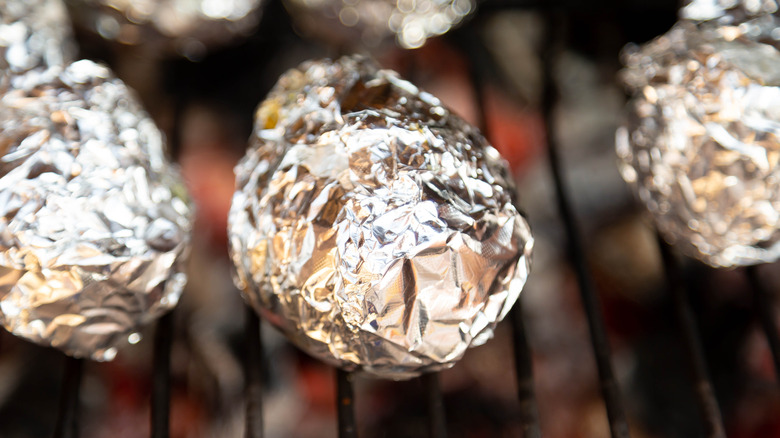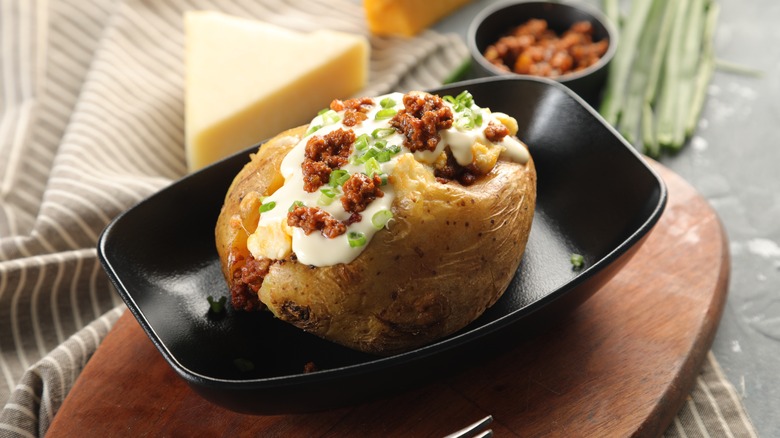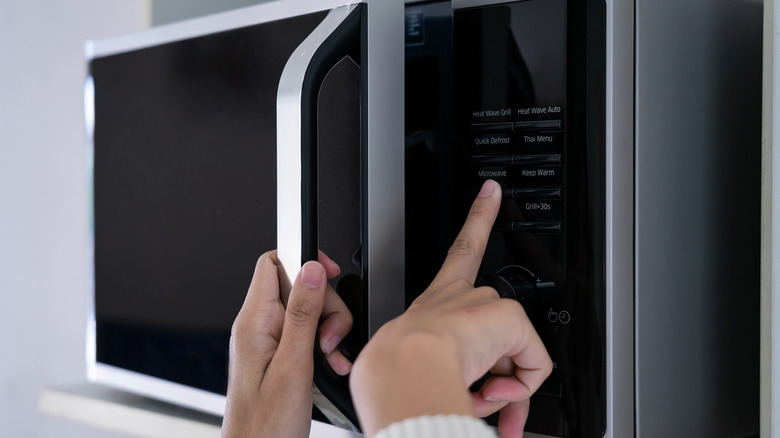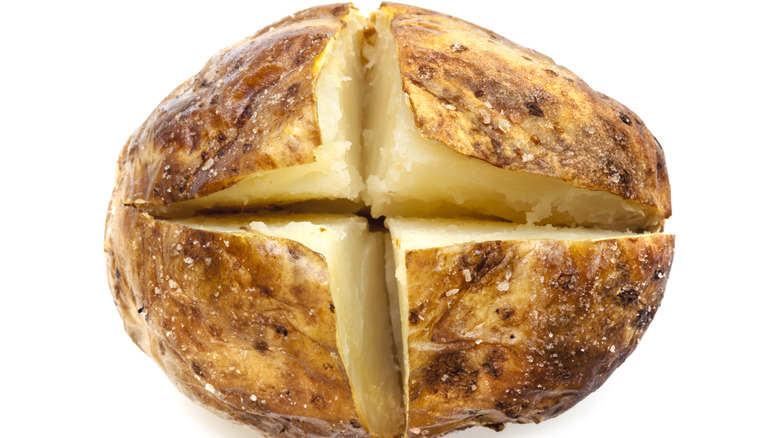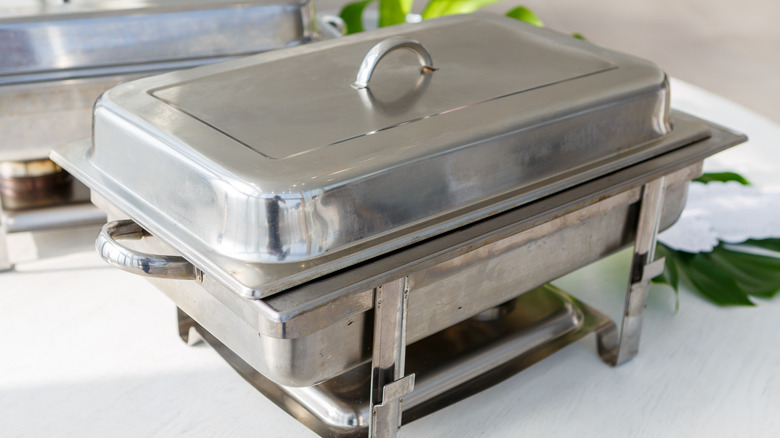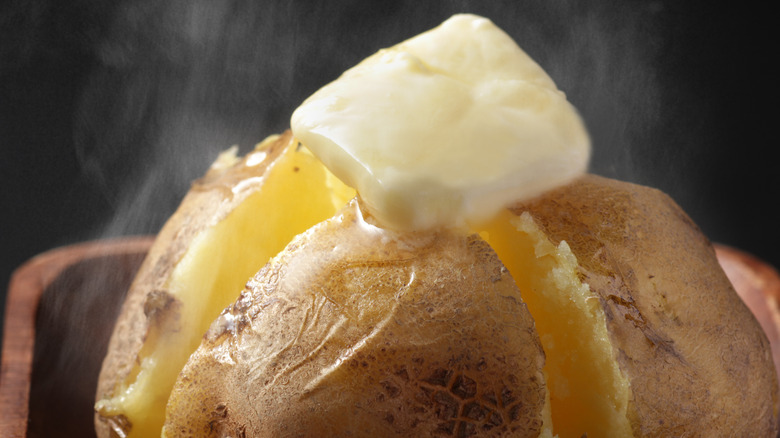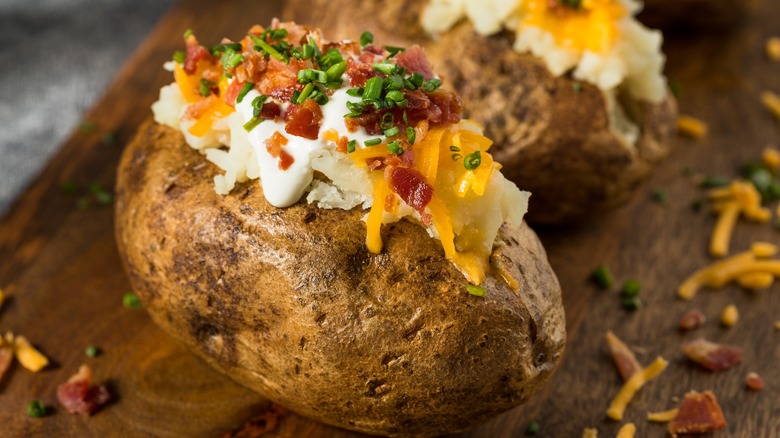Why Baked Potatoes Always Taste Better At A Restaurant
Baked potatoes always taste better at restaurants because chefs have learned how to produce a potato that's soft, fluffy, and flavorful on the inside while remaining delightfully crisp on the outside. But it's hard to replicate those results at home. If you're using the wrong type of potato and not preparing or cooking it right, then you could make gluey spuds with leathery skin. So, what are restaurants doing that you're not? Quite possibly everything.
It's possible to choose a random potato out of your pantry and stick it in the microwave for 10 minutes, but the results are nothing like what you get from a restaurant. To get restaurant-quality baked potatoes, it's important to start with the perfect produce, choose a way to salt the outside, and cook it to the perfect temperature in the oven.
You will be surprised how much better your potatoes will taste with just a few changes to your preparation and baking techniques. Once you've applied all of the tips we've gathered here, you can create restaurant-perfect spuds every time.
You're choosing the wrong type of potato
Restaurant chefs understand that, while every potato has its uses, not all potatoes are good for baking. One thing you need to pay attention to is whether you're using a starchy, waxy, or all-purpose potato. While waxy and all-purpose potatoes have their place in the cooking world, they're not the best options when it comes to creating fluffy baked potatoes. Instead, you'll want to choose a starchy spud with relatively little moisture inside. Restaurants know that russet potatoes are the best choice for baked potatoes.
Russets have a high starch content, which helps to create the fluffy texture you crave from a baked potato. Idaho potatoes are the second-best choice. Meanwhile, all-purpose potatoes like purple and Yukon Gold varieties make a decent third choice.
What about the waxy spuds? Sure, you can bake them, but you simply won't end up with the same soft and fluffy baked potato you will get in a restaurant.
You're not considering potato quality
Your best bet for getting the perfect baking potato is to shop for them individually, rather than digging through a random bag hoping to find the perfect one. That attention to detail pays off. When you're looking for the best possible potatoes to bake, you want smooth ones that don't have cuts or spots. Just like fruit, potatoes can bruise. You may not be able to see internal bruising, but you can see shatter bruising, which results in thick scar tissue on the surface and damage inside.
When a restaurant chef cuts open a baked potato and finds problems they couldn't see from the outside, they simply trash it rather than serve a low-quality potato to their customers. Other potatoes to avoid are soft ones, wrinkled ones, or those with eyes, sprouts, or green skin.
When you're baking multiple potatoes together, you'll surely want them to all get done at the same time. Thus, it's essential to choose potatoes that are all roughly the same size. Otherwise, you'll have to test the internal temperature of each to determine when it's done, or else risk overcooked or undercooked potatoes.
You're storing them the wrong way
Restaurants are careful about how they store their potatoes. If you've ever gone to your pantry for a potato only to discover that it has gone soft, turned green under the skin, or has sprouted, that's because you're not storing your potatoes properly. The best place to keep your spuds is in a cool, dark spot. Meanwhile, the ideal temperature at which to store them is 43 to 50 degrees Fahrenheit, which is warmer than your refrigerator should be but cooler than your pantry — unless it has a separate climate control like in a restaurant. Your basement or garage may stay at an acceptable temperature for potatoes, depending on how they're built and what time of the year it is. Otherwise, if you have access to a root cellar, this is where you should be keeping your potatoes and other root vegetables.
According to Healthline, keeping your root veggies at cool temperatures will help them last longer, prevent sprouting, and help them maintain more vitamin C over time. Meanwhile, keeping potatoes in the dark will prevent them from turning green and increasing solanine levels. The more solanine a potato has, the more toxic it becomes and the more likely it is to make you sick.
You're not brining them or baking them in salt
If you want to make baked potatoes that taste like a restaurant's, one secret is to use salt to enhance both the texture and flavor. You can either brine your potato, coat it in oil and salt, or even bake it on a bed of salt. Some chefs will soak their potatoes in salt water for an hour or so before baking them. Guy Fieri soaks his for an impressive six hours. Fieri sometimes goes a step further by rolling and encrusting his wet, brined potatoes in even more salt and seasonings. We've found that, if you're low on time, you will still get good results simply by soaking your potatoes in salty water while your oven preheats.
One of the most satisfying parts of eating a potato at a restaurant is getting one with a crisp skin that contrasts perfectly with the fluffy, starchy goodness inside. To accomplish this, add a coating of oil to the outside of the potato and sprinkle salt on it before putting it into the oven.
If you don't want to use oil, salt is still your friend when it comes to achieving crispy skins. All you need to do is bake your potatoes in a bed of salt. During the baking process, any moisture the potato loses will escape into the salt and then transfer back into the skin to help keep things from getting leathery.
You're starting with wet potatoes
You absolutely want to start your baked potato process by washing your potatoes, but you also don't want to put them in the oven soaking wet. Russet potatoes tend to come from the store with dirt clinging to them, unlike some waxier varieties like red potatoes. So, be sure to wash and scrub them until they don't smell like dirt anymore. Then, of course, you'll brine or salt your potatoes to make them restaurant-quality. After all this washing and brining, they will be wet, but popping them directly into the oven won't do (though if they go in coated with oil, that's fine).
Don't worry about messing with the salt coating, either. If you gently pat the potatoes dry with a paper towel or a dishcloth, salt will remain on the potato skin. If you're feeling dubious, we invite you to stick the tip of your tongue to the potato to test it. It will still be salty after a few gentle drying pats. Once you stick the potatoes in the oven, any residual water will evaporate within a minute, leaving behind skin that looks slightly chalky with salt.
You're forgetting to poke holes in them
One thing restaurants (hopefully) never forget to do is poke holes in their potatoes. If you've ever had a potato explode mid-baking, it's almost certainly because you forgot to pierce the skins. Sure, you could continue baking after the potato effectively pokes a hole in itself via an explosion, but it's not going to taste as good.
Even low-moisture russet potatoes contain some level of moisture inside, so it's essential to poke holes in your potatoes before you bake them, no matter the variety. What's going on? As the water inside the potato heats up, it turns to steam and needs somewhere to go. If you poke a hole in the skin, the steam can escape without blowing apart the spud. However, if you forget to pierce the skin a few times with a fork, the steam may make its own escape hole, resulting in an explosion and a real mess inside your oven.
You're wrapping them in foil
Since you're baking your potato and not steaming it, you'll want to avoid the foil. Yes, we know that you've seen images of potatoes wrapped in foil all your life. However, if you want restaurant-quality baked potatoes, you should leave the foil for the campfire.
If you think back to the last potato you cooked in foil, you'll likely remember that the skins ended up soggy instead of crispy. The inside probably also had more of a dense boiled potato texture rather than the fluffy baked potato interior you seek. While you may have expected the foil to bake the potato faster or help crisp up the skin, all it does is create a mini sauna. Inside the foil, any moisture the potato releases rains back down on the skin. So, if you crave crispy rather than wet and soggy potato skins, be sure to leave off the foil.
When you bake your foil-free potatoes, place them directly on the oven rack. If you're using salt rather than oil to crisp up the skins, you'll want to place your spuds on a baking tray instead. Whatever method you choose, however, be sure that it comes without foil.
You don't know how long to cook them or at what temperature
While we're accustomed to checking our meat to determine its interior temperature, we don't often think about doing the same for our potatoes. Instead, we often put them in an oven for a set amount of time, then take them out when that time is over. However, if you want the perfect, pillowy restaurant-style baked potato, the amount of time you cook them should actually be determined by your food thermometer. When it reads between 205 and 212 degrees Fahrenheit after plunging into a potato, you know you've cooked it to the perfect temperature for the softest, fluffiest texture possible.
We know you want your potatoes to make it from the oven to the table in as little time as possible. However, don't let that be an excuse to mess with the oven temperature. If you start with the temperature too high, you'll end up with potatoes that look and taste burnt. However, you can usually bake potatoes in under an hour if you set your oven to 450 degrees Fahrenheit for about 45 minutes.
You're microwaving them
Microwaving is certainly a faster way to bake potatoes, but the truth is that you're never going to achieve restaurant-quality potatoes using your microwave. Instead, you're likely to end up with an unevenly-cooked potato with an unsatisfactory texture.
We've all experienced warming up food in the microwave, only to find that some areas of the food are scalding hot, while others are still extremely cold. If you microwave your spud, you may end with some parts of it being at the perfect temperature while other areas are still too cool to achieve the correct texture. That's especially true if you're microwaving a super-sized spud.
The other problem with microwaving is that the heating process inside a microwave is too rapid. When you heat your potato quickly in the microwave rather than slowly in the oven, the cells inside the potato rupture from an increase in internal pressure. Sure, you end up cooking your potato faster, but the starch inside the potato will attempt to glue the broken cells back together. This results in a gummy potato. You will also notice that the skin isn't nice and crisp and may even wrinkle during the microwaving process.
You're not splitting the potatoes open when they're done
You may have noticed that you practically never get a baked potato from a good restaurant that isn't already split open for you. Yet the chef isn't just being nice and giving you an easy reservoir for butter and other ingredients. Instead, opening up a cooked potato is an essential part of the baking process. If you don't split it open after you take it out of the oven, you may end up with a potato that is hard and gluey inside rather than soft and pillowy.
The earlier you split open the skin the better. That's because your piping-hot spud needs somewhere to vent all the steam that has accumulated during the baking process. Even if you've poked holes in the skin before cooking, there simply isn't enough space inside the potato to accommodate all the excess moisture. So, it tries to escape. When it can't, it sticks around and ruins the texture. The faster you can cut open the skin, the less likely the inside is to change from perfect to disappointing. Even waiting 10 minutes to cut it open will alter the texture, so don't waste time.
You're not eating pre-baked potatoes
Restaurants usually bake their potatoes ahead of time. Otherwise, your meal couldn't come out of the kitchen in under 45 minutes. Once a chef bakes potatoes, they either warm them up again or keep the spuds in a warmer.
If a restaurant keeps its baked potatoes on a warmer, chefs must be sure that they put fresh potatoes on to bake regularly to accommodate the expected number of diners. However, if they underestimate that numbers, they may have to say that the restaurant's potatoes are sold out. If they do their math right, they'll always have enough in their warmer for guests until the next round gets out of the oven.
If you make your potatoes ahead of all your other dishes, try dropping the oven down to 200 degrees Fahrenheit and keeping them warm there. If you're baking something else in the oven, pop them into the warming drawer beneath your oven. Yes, we know you probably have it full of baking trays, but it's technically built to keep your food warm. Another option is to use the "keep warm" setting of your slow cooker or instant pot. An insulated cooler is also an excellent choice for keeping your potatoes hot while they wait.
You're not using real butter
Chances are that the last time you ordered a baked potato in a restaurant, they served it with real butter. Unless you're lactose intolerant or vegan, you'll have a better baked potato experience with real butter than margarine. We find its rich dairy flavor is far superior to artificial butter flavor.
To be called margarine, the ingredients in your butter substitute must be 80% fat at a bare minimum, so you're still consuming fat if you choose this route. You may find a butter substitute with less fat if you choose one labeled as "spread." If you're watching your cholesterol, you'll find that butter could be more heart-healthy than some margarine brands that may contain trans fats. Plus, a quick look at margarine ingredients will show you just how many chemicals you're consuming in comparison to butter, which only contains cream and possibly salt.
You're not adding interesting toppings
Eating a baked potato with nothing but butter and salt is fine, but most restaurants go a step further and offer loaded baked potatoes. When you serve your spuds at home, why not offer plenty of other toppings as well? If you plan ahead, for instance, you can cook bacon to crumble over the top. Even if you're short on time, you can probably find plenty of toppings to serve alongside your baked potatoes if you raid the fridge.
Shredded cheese, sour cream, and ranch dressing are obvious options that may already be waiting for you. Chopped chives are likewise easy to prepare. Also, consider fresh and canned options like olives, diced bell peppers, tomatoes, and even pickled jalapeños. You can even check to see what leftovers you have that may play well atop a baked potato. Serving baked potatoes the day after you make chili is always a crowd-pleaser, but you can also top it with creamy soups like cheddar broccoli soup. Steamed broccoli or other steamed veggies also make great choices.
